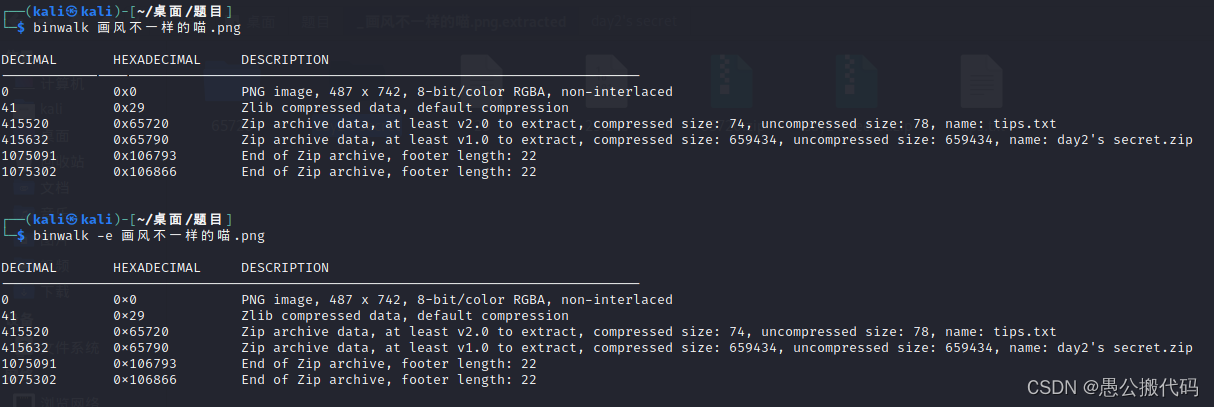【愚公系列】2021年12月 攻防世界-进阶题-MISC-071(4-1)
【摘要】 一、4-1题目链接:https://adworld.xctf.org.cn/task/task_list?type=misc&number=1&grade=1&page=4 二、答题步骤 1.binwalk输入如下命令binwalk -e 画风不一样的喵.png提取文件发现两张图片 2.盲水印盲水印脚本bwm.py#!/usr/bin/env python# -*- coding: utf...
一、4-1
题目链接:https://adworld.xctf.org.cn/task/task_list?type=misc&number=1&grade=1&page=4
二、答题步骤
1.binwalk
输入如下命令
binwalk -e 画风不一样的喵.png
提取文件

发现两张图片

2.盲水印
#!/usr/bin/env python
# -*- coding: utf8 -*-
import sys
import random
cmd = None
debug = False
seed = 20160930
oldseed = False
alpha = 3.0
if __name__ == '__main__':
if '-h' in sys.argv or '--help' in sys.argv or len(sys.argv) < 2:
print ('Usage: python bwm.py <cmd> [arg...] [opts...]')
print (' cmds:')
print (' encode <image> <watermark> <image(encoded)>')
print (' image + watermark -> image(encoded)')
print (' decode <image> <image(encoded)> <watermark>')
print (' image + image(encoded) -> watermark')
print (' opts:')
print (' --debug, Show debug')
print (' --seed <int>, Manual setting random seed (default is 20160930)')
print (' --oldseed Use python2 random algorithm.')
print (' --alpha <float>, Manual setting alpha (default is 3.0)')
sys.exit(1)
cmd = sys.argv[1]
if cmd != 'encode' and cmd != 'decode':
print ('Wrong cmd %s' % cmd)
sys.exit(1)
if '--debug' in sys.argv:
debug = True
del sys.argv[sys.argv.index('--debug')]
if '--seed' in sys.argv:
p = sys.argv.index('--seed')
if len(sys.argv) <= p+1:
print ('Missing <int> for --seed')
sys.exit(1)
seed = int(sys.argv[p+1])
del sys.argv[p+1]
del sys.argv[p]
if '--oldseed' in sys.argv:
oldseed = True
del sys.argv[sys.argv.index('--oldseed')]
if '--alpha' in sys.argv:
p = sys.argv.index('--alpha')
if len(sys.argv) <= p+1:
print ('Missing <float> for --alpha')
sys.exit(1)
alpha = float(sys.argv[p+1])
del sys.argv[p+1]
del sys.argv[p]
if len(sys.argv) < 5:
print ('Missing arg...')
sys.exit(1)
fn1 = sys.argv[2]
fn2 = sys.argv[3]
fn3 = sys.argv[4]
import cv2
import numpy as np
import matplotlib.pyplot as plt
# OpenCV是以(BGR)的顺序存储图像数据的
# 而Matplotlib是以(RGB)的顺序显示图像的
def bgr_to_rgb(img):
b, g, r = cv2.split(img)
return cv2.merge([r, g, b])
if cmd == 'encode':
print ('image<%s> + watermark<%s> -> image(encoded)<%s>' % (fn1, fn2, fn3))
img = cv2.imread(fn1)
wm = cv2.imread(fn2)
if debug:
plt.subplot(231), plt.imshow(bgr_to_rgb(img)), plt.title('image')
plt.xticks([]), plt.yticks([])
plt.subplot(234), plt.imshow(bgr_to_rgb(wm)), plt.title('watermark')
plt.xticks([]), plt.yticks([])
# print img.shape # 高, 宽, 通道
h, w = img.shape[0], img.shape[1]
hwm = np.zeros((int(h * 0.5), w, img.shape[2]))
assert hwm.shape[0] > wm.shape[0]
assert hwm.shape[1] > wm.shape[1]
hwm2 = np.copy(hwm)
for i in range(wm.shape[0]):
for j in range(wm.shape[1]):
hwm2[i][j] = wm[i][j]
if oldseed: random.seed(seed,version=1)
else: random.seed(seed)
m, n = list(range(hwm.shape[0])), list(range(hwm.shape[1]))
if oldseed:
random.shuffle(m,random=random.random)
random.shuffle(n,random=random.random)
else:
random.shuffle(m)
random.shuffle(n)
for i in range(hwm.shape[0]):
for j in range(hwm.shape[1]):
hwm[i][j] = hwm2[m[i]][n[j]]
rwm = np.zeros(img.shape)
for i in range(hwm.shape[0]):
for j in range(hwm.shape[1]):
rwm[i][j] = hwm[i][j]
rwm[rwm.shape[0] - i - 1][rwm.shape[1] - j - 1] = hwm[i][j]
if debug:
plt.subplot(235), plt.imshow(bgr_to_rgb(rwm)), \
plt.title('encrypted(watermark)')
plt.xticks([]), plt.yticks([])
f1 = np.fft.fft2(img)
f2 = f1 + alpha * rwm
_img = np.fft.ifft2(f2)
if debug:
plt.subplot(232), plt.imshow(bgr_to_rgb(np.real(f1))), \
plt.title('fft(image)')
plt.xticks([]), plt.yticks([])
img_wm = np.real(_img)
assert cv2.imwrite(fn3, img_wm, [int(cv2.IMWRITE_JPEG_QUALITY), 100])
# 这里计算下保存前后的(溢出)误差
img_wm2 = cv2.imread(fn3)
sum = 0
for i in range(img_wm.shape[0]):
for j in range(img_wm.shape[1]):
for k in range(img_wm.shape[2]):
sum += np.power(img_wm[i][j][k] - img_wm2[i][j][k], 2)
miss = np.sqrt(sum) / (img_wm.shape[0] * img_wm.shape[1] * img_wm.shape[2]) * 100
print ('Miss %s%% in save' % miss)
if debug:
plt.subplot(233), plt.imshow(bgr_to_rgb(np.uint8(img_wm))), \
plt.title('image(encoded)')
plt.xticks([]), plt.yticks([])
f2 = np.fft.fft2(img_wm)
rwm = (f2 - f1) / alpha
rwm = np.real(rwm)
wm = np.zeros(rwm.shape)
for i in range(int(rwm.shape[0] * 0.5)):
for j in range(rwm.shape[1]):
wm[m[i]][n[j]] = np.uint8(rwm[i][j])
for i in range(int(rwm.shape[0] * 0.5)):
for j in range(rwm.shape[1]):
wm[rwm.shape[0] - i - 1][rwm.shape[1] - j - 1] = wm[i][j]
if debug:
assert cv2.imwrite('_bwm.debug.wm.jpg', wm)
plt.subplot(236), plt.imshow(bgr_to_rgb(wm)), plt.title(u'watermark')
plt.xticks([]), plt.yticks([])
if debug:
plt.show()
elif cmd == 'decode':
print ('image<%s> + image(encoded)<%s> -> watermark<%s>' % (fn1, fn2, fn3))
img = cv2.imread(fn1)
img_wm = cv2.imread(fn2)
if debug:
plt.subplot(231), plt.imshow(bgr_to_rgb(img)), plt.title('image')
plt.xticks([]), plt.yticks([])
plt.subplot(234), plt.imshow(bgr_to_rgb(img_wm)), plt.title('image(encoded)')
plt.xticks([]), plt.yticks([])
if oldseed: random.seed(seed,version=1)
else: random.seed(seed)
m, n = list(range(int(img.shape[0] * 0.5))), list(range(img.shape[1]))
if oldseed:
random.shuffle(m,random=random.random)
random.shuffle(n,random=random.random)
else:
random.shuffle(m)
random.shuffle(n)
f1 = np.fft.fft2(img)
f2 = np.fft.fft2(img_wm)
if debug:
plt.subplot(232), plt.imshow(bgr_to_rgb(np.real(f1))), \
plt.title('fft(image)')
plt.xticks([]), plt.yticks([])
plt.subplot(235), plt.imshow(bgr_to_rgb(np.real(f1))), \
plt.title('fft(image(encoded))')
plt.xticks([]), plt.yticks([])
rwm = (f2 - f1) / alpha
rwm = np.real(rwm)
if debug:
plt.subplot(233), plt.imshow(bgr_to_rgb(rwm)), \
plt.title('encrypted(watermark)')
plt.xticks([]), plt.yticks([])
wm = np.zeros(rwm.shape)
for i in range(int(rwm.shape[0] * 0.5)):
for j in range(rwm.shape[1]):
wm[m[i]][n[j]] = np.uint8(rwm[i][j])
for i in range(int(rwm.shape[0] * 0.5)):
for j in range(rwm.shape[1]):
wm[rwm.shape[0] - i - 1][rwm.shape[1] - j - 1] = wm[i][j]
assert cv2.imwrite(fn3, wm)
if debug:
plt.subplot(236), plt.imshow(bgr_to_rgb(wm)), plt.title(u'watermark')
plt.xticks([]), plt.yticks([])
if debug:
plt.show()
保存requirements.txt文件
opencv-python==4.2.0.34
matplotlib==2.1.1
执行命令安装对应包
pip install -r requirements.txt
提取图中的盲水印
python bwm.py decode day1.png day2.png day3.png --oldseed

Flag:wdflag{My_c4t_Ho}
总结
- binwalk
- 盲水印
数字水印(Digital Watermark)一种应用计算机算法嵌入载体文件的保护信息。数字水印技术,是一种基于内容的、非密码机制的计算机信息隐藏技术。它是将一些标识信息(即数字水印)直接嵌入数字载体当中(包括多媒体、文档、软件等)或是间接表示(修改特定区域的结构),且不影响原载体的使用价值,也不容易被探知和再次修改。但可以被生产方识别和辨认。通过这些隐藏在载体中的信息,可以达到确认内容创建者、购买者、传送隐秘信息或者判断载体是否被篡改等目的。数字水印是保护信息安全、实现防伪溯源、版权保护的有效办法,是信息隐藏技术研究领域的重要分支和研究方向。
【声明】本内容来自华为云开发者社区博主,不代表华为云及华为云开发者社区的观点和立场。转载时必须标注文章的来源(华为云社区)、文章链接、文章作者等基本信息,否则作者和本社区有权追究责任。如果您发现本社区中有涉嫌抄袭的内容,欢迎发送邮件进行举报,并提供相关证据,一经查实,本社区将立刻删除涉嫌侵权内容,举报邮箱:
cloudbbs@huaweicloud.com
- 点赞
- 收藏
- 关注作者


评论(0)